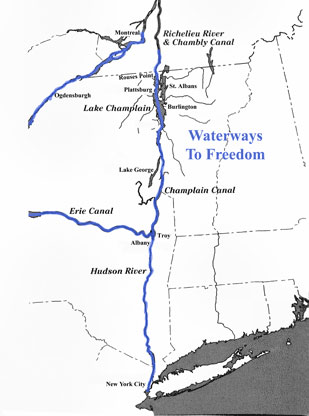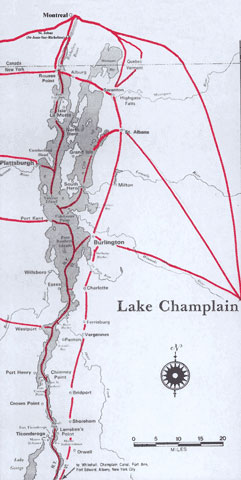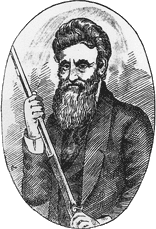Underground Railroad (UGRR) Passageways in New York
The Banner of Liberty, a decidedly anti-abolitionist newspaper from the Hudson Valley, announced in 1860:
The underground railroad is no myth. A regular organization, to which this name has been applied, stretches through every free State in the Union, and has its agents and emissaries on the borders of every slave State and along all the routes traveled by fugitive slaves....In all the principal cities in the State of New York—in New York, Albany, Utica, Syracuse, Rochester, Buffalo and other places—regular agents are located, and subscriptions are solicited.
New York had several heavily trafficked Underground Railroad routes. Some ended at Niagara Falls. Others led to cities on the Erie Canal or Lake Ontario via the Oswego Canal. The most important route in New York began in New York City and led to the state's capital, Albany, where a Committee of Vigilance gained the reputation of being the most efficient UGRR organization in the State. Troy, another important center of UGRR activity, was on the opposite bank of the Hudson River.

From the Capital region, most freedom seekers followed the Erie Canal to Canada. However, some followed the Upper Hudson River to the Champlain Canal and Lake Champlain. This series of interconnected waterways to freedom (and adjacent land routes) were the principal Underground Railroad passageway through the Champlain Valley. It was an ideal corridor to liberty. Lake Champlain lay between New York's Adirondack Mountains and Vermont's Green Mountains. It was a great 150-mile-long watershed which flowed north into Canada's Richelieu River and provided easy access to Montreal. The Champlain Canal facilitated the movement of freedom seekers when it opened in 1823. Then in the 1850s, rail routes to Montreal from Vermont and New York became increasingly important. From Montreal, some refugees followed the St. Lawrence River upstream to Canada West where a number of refugee communities were established.

Region Served by the Champlain Line
The Champlain Line of the Underground Railroad was an extension of the Eastern Seaboard Line. It encompassed routes from Baltimore, Maryland; Wilmington, Delaware; Washington DC, and Philadelphia, Pennsylvania. It was the final link between New York City and terminal points in Northeastern New York, Vermont and Canada. It was the last stretch in a series of road, rail and water routes from Manhattan to Montreal. It was also the last link of the "Vermont Road" from Massachusetts to Lake Champlain.
Importance of the Champlain Line
The Champlain Line offered freedom seekers a number of options. Some boarded Champlain Canal packet boats, transferred to steamboats at the Southern end of Lake Champlain in Whitehall, and then made their way North to ports on Lake Champlain. Some continued directly to St. John, Québec. When Lake Champlain was frozen, fugitives were forwarded onto land routes from Troy, New York, to Vermont. Others may have followed the Great State Road in New York from Albany to the border.
Some freedom seekers came to the Champlain Valley from New England by rail. The terrain in Northeastern New York just below the Canadian border encouraged the construction of a railroad, for it was not mountainous. The first through train from Lake Champlain steamed into Ogdensburg to great fanfare on September 18, 1850. Two days later, Congress passed a punitive Fugitive Slave Bill, and hundreds of people who had escaped to the North began to flee to Canada. A swing bridge across Lake Champlain completed the rail route from Boston to Ogdensburg in 1851. Ogdensburg provided easy access to Canada because it was at the narrowest point on the St. Lawrence River and had steamboat service to Canada.
The Champlain Line's roads, railroads and steamboats facilitated the movement of an untold number of fugitive slaves to the Queen's Dominions. They arrived singly, in family units, in small groups, and they came steadily. Hundreds of people made their way to the Champlain Valley. Stephen Keese Smith of Peru, New York, spent a thousand dollars or more assisting fugitive slaves.
In the Northeastern United States, the Champlain Line of the Underground Railroad became a major operation. It provided direct access to Eastern and Western Canada through Vermont and Northeastern New York.
Key Stops
Fugitive slaves came into New York from Washington DC, the Atlantic Seaboard states, and the Gulf Coast. Some escaped from New Orleans, Savannah, Charleston, or Norfolk and other southern seaports and landed in Philadelphia, New York City or New Bedford, Massachusetts. They stowed away on ships where they were hidden by black and white seamen. Others escaped by land or rail. Only the strongest survived.
The key UGRR stops in New York which fed the Champlain Line were New York City, Albany, and Troy. At the Northern end of Lake Champlain, Rouses Point's rail and boat terminal made it the most important stop on the New York side of the lake. Key Champlain Line stops in western Vermont were Ferrisburgh, Burlington, Swanton, and St. Albans. Fugitive slaves followed the Champlain Line to several terminal points in Canada including St. Johns (Saint-Jean-sur-Richelieu), Montreal and Toronto.
Many factors determined the specific route freedom seekers followed and the length of time it took them to reach their destination. Agents either forwarded them to or took them to trusted friends. Sometimes freedom seekers had little more than a God given faith that kind hearted people would help them. Some abolitionists employed freedom seekers for short or extended periods of time. This provided them with the money they needed to continue their journey. Some fugitives sought out family or friends who had already found refuge in Québec, Ontario, northern New York or Vermont. Some decided to stay in Vermont or Northeastern New York. Others went to Montreal or border communities in Lower Canada. Most of the fugitives, however, sought refuge in Upper Canada.
All routes in Vermont led to freedom. The Green Mountain State was an underground crossroads wedged between Canada, New Hampshire, Massachusetts, New York and Lake Champlain. Fugitive slaves were forwarded or taken to Vermont from Pennsylvania, New York, Massachusetts, and Connecticut. Sympathetic abolitionists made Vermont a safe haven, but geography made it an Underground Railroad thoroughfare. A relatively flat plain along Vermont's Lake Champlain shore enabled fugitive slaves to circumvent New York's Adirondack Mountains. Champlain Canal towboats and Lake Champlain steamers facilitated their travel. Stage and rail lines connected Albany and Troy, New York, to Vermont and Montreal, Canada. Cities in New England were also linked by rail to Montreal through Vermont. From the Green Mountain State, many fugitives were sent directly to Montreal or across Lake Champlain to the New York side of the lake so they could continue their journey to Canada West.
The people of Lake Champlain Corridor lived every phase of the anti-slavery struggle. They experienced or witnessed slavery, gradual manumission, Liberian colonization, the call for immediate emancipation, the Underground Railroad, political activism, imprisonment and martyrdom. They defied the Fugitive Slave Bill of 1850, and they supported the Civil War which finally ended chattel slavery. Champlain Line UGRR agents, station masters and conductors represented the full range of anti-slavery sentiments— from pacifism to armed insurrection.
John Brown
The anti-slavery struggle came to a climax when Adirondack settler John Brown ignited the Civil War with his raid on the federal arsenal at Harper's Ferry in 1859.

John Brown
For stories of people and places on the Champlain Line of the Underground Railroad go to People and Places.
So their plans to escape would not be detected, slaves substituted the word "Canaan" for Canada. Canaan was the Biblical land God promised the Israelites who escaped from slavery in Egypt. Queen Victoria promised freedom in Canada and bestowed citizenship to refugees from slavery in the United States.






